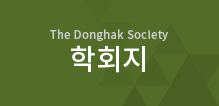pISSN: 1598-7566 / eISSN: 2713-3605
동학학보, Vol.74 (2025)
pp.5~44
DOI : 10.46639/kjds.2025.74.1
동학과 교육 - <동학다시읽기> 강의를 마치고 -
본 논문은 필자가 강의한 2022년 1학기 <동학다시읽기>라는 수업에 대한 회고 및 평가를 다룬 연구이다. 원래 이 수업은 경희대학교 후마 니타스칼리지에서 교과목의 다양화를 꾀하기 위해 개설된 과목이었다. 특히 교양수업 안에서 서양사상보다는 다소 적게 개설된 한국사상에 대한 교육을 확대하기 위해 기획되었다. 강좌 <동학다시읽기>는 고전읽기의 일환으로의 동학 경전읽기가 아 니라, 동학사상의 탄생부터 현재까지의 내용을 전반적으로 소개하는 것으로 기획되었다. 따라서 이 수업은 대체로 2가지의 거시적 차원을 아우르는 방향으로 구성되었다. 첫째는 인문 교양 수업 안에서 동학이 라는 ‘종교이자 사상인 대상을 어떻게 가르칠 것인가’에 대한 주의를 기울이는 것이며, 둘째로는 전형적인 인문학의 특성을 살리면서, 정해 진 답보다는 다양성을 가지고 수업에 접근하는 방법을 모색해보았다. 이러한 전제를 바탕으로 하여 본 논문은 다음과 같은 과정을 통해 진행되었다. 첫째, 한 학기 동안 강좌가 어떻게 진행되었는가를 소개한다. 즉 수업 흐름에 대해 전반적으로 설명한다(II장). 둘째, 수업의 결과에서 필자가 도출한 유의미한 특성에 대해 평가해 본다. 여기서는 먼저 비록 팬데믹 여파로 소극적으로 수행될 수밖에 없었지만 유적지 탐방에 대한 나름대로의 성과를 재평가해보고 또한 수업 중 학생들에게 부과한 에세이에 대해 검토해 본다. 그리고 팀과 제로서 신문만들기 즉, 학생들이 수업시간에 배운 동학사상을 근거로 하여 제작한 신문내용을 간략히 소개해본다(III장). 셋째, 필자가 강의 후 수강자 학생들에게 실시한 설문조사 -동학을 중심으로 종교와 사상의 관계, 혹은 수강생의 종교 유무의 관계 등등- 를 통해 도출한 결과에 대해 구체적으로 논의해 보기로 한다(IV장). 넷째, 결론으로 강의 후 수업 결과에 대한 재평가 및 동학 강의에 대한 미래적 전망에 대해 논의한다(V장).
Donghak and Education : After the Class, “Re-visiting Donghak”
This paper is a study on the retrospective and evaluation of the class, “Re-visiting Donghak” that I taught in the first semester of 2022. Originally, this class was opened to diversify the curriculum at Humanitas College, Kyung Hee University. In particular, it was designed to expand education on Korean thought, which was opened somewhat less than Western thought, in liberal arts classes. The course, “Re-visiting Donghak” was not designed to read the scriptures as part of reading the classics, but to introduce the overall from the birth of Donghak thought to the present. Therefore, this class was structured to encompass two major dimensions. At first, it paid attention to how to teach Donghak, which is both a religion and a thought, in liberal arts classes, and secondly, it sought to find a way to approach the class with diversity rather than a set answer taking advantage of a typical feature of the humanities. Based on these premises, this paper proceeded through the following process. First, I will introduce how the course was conducted during the semester. In other words, it provides an overall explanation of the flow of the class. (Chapter II). Second, I will evaluate the significant characteristics that I derived from the results of the class. Here, I will first reevaluate the results of the assignment of ‘exploring Donghak historical sites’, which was inevitably carried out being scaled back due to the pandemic, and also review ‘the essays’ assigned to students during class. And as a team project, I will briefly introduce ‘Donghak newspapers’ that students produced based on the thought and history of Donghak they learned in the class (Chapter III). Third, I will discuss in detail the results derived from the survey conducted at the end of class, such as the relationship between religion and thought, or the relationship between the students’ religions focusing on Donghak (Chapter IV). Finally, as a conclusion, I will discuss the re-evaluation of the results of the class and the future prospects for teaching Donghak in class (Chapter V).








